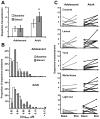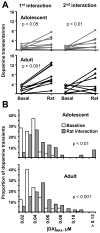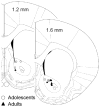Fast dopamine release events in the nucleus accumbens of early adolescent rats
- PMID: 21182904
- PMCID: PMC3061289
- DOI: 10.1016/j.neuroscience.2010.12.016
Fast dopamine release events in the nucleus accumbens of early adolescent rats
Abstract
Subsecond fluctuations in dopamine (dopamine transients) in the nucleus accumbens are often time-locked to rewards and cues and provide an important learning signal during reward processing. As the mesolimbic dopamine system undergoes dynamic changes during adolescence in the rat, it is possible that dopamine transients encode reward and stimulus presentations differently in adolescents. However, to date no measurements of dopamine transients in awake adolescents have been made. Thus, we used fast scan cyclic voltammetry to measure dopamine transients in the nucleus accumbens core of male rats (29-30 days of age) at baseline and with the presentation of various stimuli that have been shown to trigger dopamine release in adult rats. We found that dopamine transients were detectable in adolescent rats and occurred at a baseline rate similar to adult rats (71-72 days of age). However, unlike adults, adolescent rats did not reliably exhibit dopamine transients at the unexpected presentation of visual, audible and odorous stimuli. In contrast, brief interaction with another rat increased dopamine transients in both adolescent and adult rats. While this effect habituated in adults at a second interaction, it persisted in the adolescents. These data are the first demonstration of dopamine transients in adolescent rats and reveal an important divergence from adults in the occurrence of these transients that may result in differential learning about rewards.
Copyright © 2011 IBRO. Published by Elsevier Ltd. All rights reserved.
Figures



References
-
- Andersen SL, Rutstein M, Benzo JM, Hostetter JC, Teicher MH. Sex differences in dopamine receptor overproduction and elimination. Neuroreport. 1997;8:1495–1498. - PubMed
-
- Badanich KA, Adler KJ, Kirstein CL. Adolescents differ from adults in cocaine conditioned place preference and cocaine-induced dopamine in the nucleus accumbens septi. Eur J Pharmacol. 2006;550:95–106. - PubMed
-
- Day JJ, Roitman MF, Wightman RM, Carelli RM. Associative learning mediates dynamic shifts in dopamine signaling in the nucleus accumbens. Nat Neurosci. 2007;10:1020–1028. - PubMed
-
- Depue RA, Iacono WG. Neurobehavioral aspects of affective disorders. Annu Rev Psychol. 1989;40:457–492. - PubMed
Publication types
MeSH terms
Substances
Grants and funding
LinkOut - more resources
Full Text Sources
Medical
Research Materials

